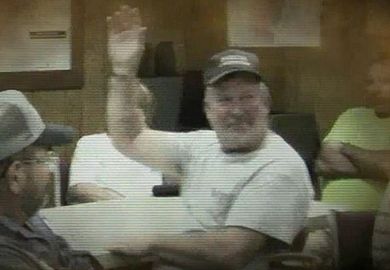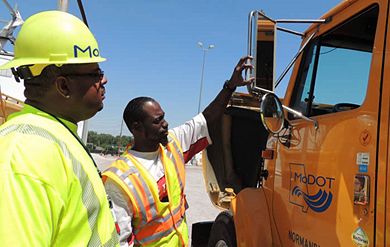Main Page: Difference between revisions
m EPG 101, QRGs |
m EPG 130 |
||
| Line 37: | Line 37: | ||
{| style="margin: 1em auto 1em auto" style="background-color: #F8F8FF" | {| style="margin: 1em auto 1em auto" style="background-color: #F8F8FF" | ||
|- | |- | ||
|colspan="2"|'''Perhaps you've wondered how many hits the most popular EPG articles have. As of | |colspan="2"|'''Perhaps you've wondered how many hits the most popular EPG articles have. As of early September, the numbers of hits are:''' | ||
|- | |- | ||
|'''20.''' [[:Category:136 Local Public Agency (LPA) Policy|EPG 136]], | |'''20.''' [[:Category:136 Local Public Agency (LPA) Policy|EPG 136]], 44826||'''10.''' [[:Category:903 Highway Signing|EPG 903]], 77451 | ||
|- | |- | ||
|'''19.''' [[:Category:1000 MATERIALS|EPG 1000]], | |'''19.''' [[:Category:1000 MATERIALS|EPG 1000]], 56798||'''9.''' [[:Category:616 Temporary Traffic Control|EPG 616]], 94484 | ||
|- | |- | ||
|'''18.''' [[903.5 Regulatory Signs|EPG 903.5]], | |'''18.''' [[903.5 Regulatory Signs|EPG 903.5]], 61089||'''8.''' [[616.23 Traffic Control for Field Operations|EPG 616.23]], 106857 | ||
|- | |- | ||
|'''17.''' [[751.13 Expansion Devices|EPG 751.13]], | |'''17.''' [[751.13 Expansion Devices|EPG 751.13]], 62990||'''7.''' [[:Category:200 GEOMETRICS|EPG 200]], 107480 | ||
|- | |- | ||
|'''16.''' [[751.5 Standard Details|EPG 751.5]], | |'''16.''' [[751.5 Standard Details|EPG 751.5]], 64795 ||'''6.''' [[:Category:600 INCIDENTAL CONSTRUCTION|EPG 600]], 130231 | ||
|- | |- | ||
|'''15.''' [[903.6 Warning Signs|EPG 903.6]], | |'''15.''' [[903.6 Warning Signs|EPG 903.6]], 66017 ||'''5.''' [[:Category:100 GENERAL|EPG 100]], 155303 | ||
|- | |- | ||
|'''14.''' [[620.2 Pavement and Curb Markings (MUTCD Chapter 3B)|EPG 620.2]], | |'''14.''' [[620.2 Pavement and Curb Markings (MUTCD Chapter 3B)|EPG 620.2]], 67392||'''4.''' [[:Category:700 STRUCTURES AND HYDRAULICS|EPG 700]], 161832 | ||
|- | |- | ||
|'''13.''' [[:Category:101 Standard Forms|EPG 101]], | |'''13.''' [[:Category:101 Standard Forms|EPG 101]], 69429 ||'''3.''' [[:Category:751 LRFD Bridge Design Guidelines|EPG 751]], 168570 | ||
|- | |- | ||
|'''12.''' [[751.40 Widening and Repair (Non-LRFD)|EPG 751.40]], | |'''12.''' [[751.40 Widening and Repair (Non-LRFD)|EPG 751.40]], 72629||'''2.''' [[:Category:900 TRAFFIC CONTROL|EPG 900]], 179439 | ||
|- | |- | ||
|'''11.''' [[:Category:400 FLEXIBLE PAVEMENT|EPG 400]], | |'''11.''' [[:Category:400 FLEXIBLE PAVEMENT|EPG 400]], 72945||'''1.''' EPG Main Page, 802088 | ||
|} | |} | ||
|valign="top" cellspacing="0" cellpadding="5" style="border: 1px solid #FFA500; background:#ffdead"| | |valign="top" cellspacing="0" cellpadding="5" style="border: 1px solid #FFA500; background:#ffdead"| | ||
'''Value Engineering''' | |||
9/4/12: [[:Category:130 Value Engineering|EPG 130 Value Engineering]] was clarified to bring guidance in line with nationwide VE standards. | |||
'''Three Updated QRGs ''' | '''Three Updated QRGs ''' | ||
| Line 156: | Line 160: | ||
7/25/12: New guidance for Safety Edge<sup>SM</sup>. This concept consists of beveling the edge of an HMA pavement during placement, to provide a smooth height transition for future errant vehicles to regain the roadway. The Safety Edge<sup>SM</sup> is easy to construct, uses very little additional material, and has the residual benefit of increasing the compaction of the edge. | 7/25/12: New guidance for Safety Edge<sup>SM</sup>. This concept consists of beveling the edge of an HMA pavement during placement, to provide a smooth height transition for future errant vehicles to regain the roadway. The Safety Edge<sup>SM</sup> is easy to construct, uses very little additional material, and has the residual benefit of increasing the compaction of the edge. | ||
Revision as of 10:31, 4 September 2012

| HELPFUL EPG VIDEOS: | •Logging into the EPG | |
| •Finding Info in the EPG | ||
| •Article History & How to Receive EMails When Articles are Revised |
| RECENT POLICY CHANGES IN THE EPG | |||||||||||||||||||||||
|
MoDOT has made great strides to build a good transportation system and increase taxpayers' trust in its ability to deliver what was promised. Innovative concepts, such as Practical Design and design-build, were used to deliver those commitments and have made MoDOT a leader in the transportation industry. These forward-thinking, innovative concepts are reflected in the ENGINEERING POLICY GUIDE (EPG). This document provides a single reference for all engineering and engineering-related guidance by combining the former Right of Way, Design, Bridge, Construction, Traffic and Maintenance manuals. MediaWiki, the engine behind the Wikipedia on the World Wide Web, is the software delivering the EPG. Millions of hits on the EPG endorse this format to be easy to navigate and pleasing to read. A small HELP ARTICLE is included to assist with helpful hints on how to use the EPG as well as other points of interest.  
|
Value Engineering 9/4/12: EPG 130 Value Engineering was clarified to bring guidance in line with nationwide VE standards. Three Updated QRGs 8/31/12: Contractor Pay Estimates, Daily Work Reports and Subcontracts were updated. Navigable Waters Insurance Protection 8/30/12: Navigable Waters Insurance Protection guidance was added to help Resident Engineers understand when this special type of insurance is required and what is needed to verify coverage. Prime Consultants and Subconsultants 8/29/12: In EPG 134.1.3 Consultant Qualification, guidance was clarified for qualification. Anchor Bolts Used on Weathering Steel Bridges 8/28/12: Bridge has clarified some the H3c and d Bearings Standard Detailing Notes to change the requirement for anchor bolts used on weathering steel bridges to coated with inorganic zinc primer. Also, in numerous notes and figures, especially in EPG 751.11.3 Details, "rod" was changed to "bolt", as in "anchor bolt". Full Depth Pavement Repair Dowel Bars 8/28/12: New guidance instructs designers calculating quantities for full depth repairs that each dowel bar is to be counted separately as a pay item, regardless of whether being drilled into a slab or placed as part of a dowel basket with other bars. Links to Free Web-based NHI Training 8/27/12: Links to NHI's Transportation Curriculum Coordination Council courses are now available at EPG 106.18 Technician Certification Program. Overcoating Existing Steel Standard Detailing Notes 8/24/12: Three paint notes were modified, primarily revising an existing note that prime coat shall not be required for calcium sulfonate overcoating projects. Two Updated QRGs 8/23/12: Change Orders – Value Engineering and Job Order Contracts were updated. Widening and Repair of Bridges 8/23/12: Bridge has updated numerous figures in EPG 751.40.2.4.1 Cast-In-Place Deck With (and Without) an Existing Wearing Surface, Hydro Demolition to match the standard plans. Consultant Contract Invoicing 8/22/12: The invoice template guidance was clarified and slightly expanded in EPG 134.5.1 Invoicing. 8/20/12: An acceptance statement was added to clarify the method of acceptance for mulch overspray. Girder/Beam Chairs and Concrete Pile Cap Integral End Bents 8/14/12: Bridge Division has clarified guidance for girder chairs and for reinforcement of concrete pile cap integral end bents. Table 1020.4.17 Tensile Strength of Lock Seams 8/9/12: This table's values have been updated to conform with AASHTO and ASTM standard practices. 8/9/12: The table of unit weights of dead load was updated to conform with AASHTO Table 3.5.1-1. 8/3/12: A Safety EdgeSM constructed at the edge of each shoulder has been added as a minimum expectation for minor route shouldering projects. 8/2/12: Bridge has produced directions on how to copy detailing notes from the EPG to MicroStation drawings. Minor Routes Shouldering Project Guidelines 8/2/12: Since the public perceives shoulders as an enhancement to the transportation system and consistently identifies them as a top tier desire, this new article facilitates the design of shoulders for minor routes. 7/31/12: Guidance for the procurement process and implementation procedures has been expanded in this article. Two Updated QRGs 7/31/12: Contract Adjustments and Line Item Adjustments were updated. New Adopt-A-Highway Signs 7/26/12: New guidance has been added to EPG 903.9.6 for the updated signs. Sequential Flashing Warning Light 7/26/12: Fig. 616.6.83 has been added for additional guidance. New Guardrail Height Requirement 7/25/12: Guidance was revised with the new guardrail height requirements per FHWA and AASHTO. New height requirements were also provided for using guardrail with urban sections of curb and curb and gutter. 7/25/12: This new article includes guidance for Add Alternate Bidding (additional items of work that the contractors all bid on and may be awarded if the bids come within the budget specified in the bidding documents), Job Order Contracting (JOC) (a procurement process that allows MoDOT to award fixed price construction contracts with indefinite delivery and indefinite quantities at individual work locations throughout the project limits) and Alternative Technical Concepts (a proposed change to agency-supplied base design configurations, project scope, design criteria or construction criteria that provides a solution that is equal or better to the requirement in the contract). 7/25/12: New guidance for Safety EdgeSM. This concept consists of beveling the edge of an HMA pavement during placement, to provide a smooth height transition for future errant vehicles to regain the roadway. The Safety EdgeSM is easy to construct, uses very little additional material, and has the residual benefit of increasing the compaction of the edge. |
||||||||||||||||||||||

